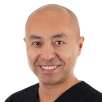Non-precious metal alloys are enjoying increased demand in dental technology. Additive manufacturing with laser melting ensures the uniformity and accuracy of ceramic-veneered, non-precious metal restorations created from powder using laser energy. Are the traditional manufacturing processes of dental technicians, such as casting and milling, making a comeback? CAD/CAM magazine spoke with Master Dental Technician Dieter Spitzer of Unicim, a manufacturer of dental restorations based in Berschis in the Swiss canton of St. Gallen, Switzerland.
Digital process networking is linking dentists, laboratories and dental manufacturers more closely than ever and putting everyone involved under pressure to act. The entire process chain, from impression taking to prosthetic restoration, is undergoing a dynamic transition—a trend away from casting and toward digital additive manufacturing.
CAD/CAM: Mr Spitzer, you refer to Unicim as a digital production centre. What do you mean by that?
Dieter Spitzer: Unicim combines traditional production methods with digital CAD/CAM manufacturing, such as metal laser melting and powderbased plastic laser sintering. With rapid manufacturing methods, you can select the most functional and affordable dental prosthetic solution based on your customer’s needs, be it crowns and bridges, frameworks, primary and secondary structures, or implant superstructures.
embedImagecenter("Imagecenter_1_1059",1059, "large");
Can you give us an idea of the process of creating dental restorations from metallic powders using additive manufacturing technology?
Once the 3-D CAD data is complete, the support structures are set up using data-processing software.
Various software solutions are available for this purpose. One of the most common is CAMbridge, which requires licence fees. Alternatively, there is AutoFab Mlab, which is licence-free and allows you to assign specific measurements. With Concept Laser’s systems, the customer is able to choose freely and is not bound by any software. The processed data is transmitted to the machine via the network or USB port and the construction job is started. With this process, you can finish a project fully automatically overnight. Once complete, the components are removed from the building board and refinished. After manually removing the support structures, the surface is then micro-blasted with aluminium oxide, and the crown edges are thinned down in the case of bridges.
Will milling and casting soon be a thing of the past in dental prosthetics?
Milling and casting will remain part of the standard repertoire of dental laboratories for training and application. Additive manufacturing options will offer many advantages in the future and reduce production risk enormously. Unfortunately, they are still far too rarely seen in practice by dentists and dental technicians. Some of this has to do with the old school mentality of doing everything manually.
The dental laboratory of the future will be more of a hybrid: milling and casting where desirable but with additive manufacturing as a top alternative. “Add on versus take away,” I like to call it. In summary, the casting process, from the cast object to the finished product, is usually very time-consuming and can lead to distortion, especially with large-span restorations. With additive technology, we achieve contour accuracy more easily than with milling. Our workplaces in dental technology are also cleaner thanks to CAD/CAM: less dust, bonding agent, glue, and outgassing. Ultimately, the deciding factor is quality. Compared with casting and milling, additive printing processes are creating entirely new ways of thinking in terms of production, workflow and the products themselves.
How are these changes expressed?
We need to look at different levels here. First is the transition from manual craftsmanship to high-precision, high-accuracy industrial CAD/CAM production. Milled non-precious metal restorations have significant disadvantages owing to material consumption: high production costs and system-related lower quality in terms of fit and shape retention. During casting, we also encounter disadvantages in terms of low material density, mould costs, production time and rework. Nearly all of these disadvantages disappear with laser melting. By using proven materials like remanium star CL and rematitan CL from Dentaurum with our Mlab cusing R, we have been very satisfied with the quality of our system-manufactured products. In the case of large-volume restorations, any excess tension that arises can be alleviated through subsequent heat treatment, thus avoiding any potential distortion. Of course, the same applies to cobalt–chromium alloys or titanium.
You mentioned changes to the products. What changes were you referring to?
I’m quite optimistic. I’ll describe a couple of them. First, the geometric flexibility of prostheses is enabling a new way of looking at shapes or functions. In the future, imagine restorations with channels into which medications can be fed. The dentist or orthodontist can provide treatment, and the patient will not have to deal with temporaries. The second major change is the selective density of a component made possible by the process. Thus, for example, not only can bridges with more than ten sections be manufactured in a one-step process tension-free, but they can also be increasingly applied in heavily utilised areas, such as cantilevers, edges or brace elastics. In model casting, that is not always an easy problem to solve.
Geometric freedom is a genuine plus for us, as it opens up new possibilities for restoration design. For example, brace elements can be made much finer while retaining sufficient mechanical properties. These new options also increase the longevity of dental products. In casting or mil ling, we have to deal with cost, material waste and lower material density; in casting especially, we have oversized dimensions and much lower material den sities. With cast restorations, breakage is always an issue. But it does not have to be that way. Another benefit is the ability to create combinations through module or multicomponent construction methods. Base elements implanted into the jawbone are used as primary structures. An additively manufactured foundation element is then put into place as a secondary structure, on to which a secure, durable veneer such as HeraCeram is applied. Another aspect relates to new materials, such as non-precious metal titanium.
Titanium is hard and biocompatible.
Titanium is the ideal material for allergy sufferers, for example. In combination with laser melting and veneering, we can maximise its biological benefits. From a visual standpoint, titanium restorations offer a risk-free silver-grey lustre. Manufacturers of non-precious metal alloys have spread pseudoscientific criticism regarding the aesthetics of titanium. Low-dose fluoride in toothpaste or mouthwash, for example, has no impact on appearance. We cannot deny the reality that titanium has not only caught up with non-precious metal alloys in importance, but also surpassed them. This is precisely why, in 2012, Unicim invested in an Mlab cusing R system for titanium applications from Concept Laser, which allows us to process reactive titanium material in a closed system. The unit can be used with dental materials certified under the German Medical Devices Act, such as rematitan CL from Dentaurum. Because of the high amount of material waste, milling-based processing of titanium is too expensive and casting is highly impractical.
What are some of the problems that arise in the casting of titanium?
The reaction of titanium with oxygen causes the formation of an alpha-case layer on the outside.
This leads to embrittlement of the surface and must be removed. If not removed, it can lead to problems with the adhesion of veneering. With LaserCUSING, no alpha-case layer forms. This makes laser melting with titanium powder excellent for processing. The very fine-grained microstructure of the laser-fused parts of this titanium alloy allows greater firmness than with conventional castings. The dentist receives a high-performance, long-life alternative that is easy to work on and more affordable than a precious metal solution. Finally, dentists and patients can benefit from a quality product that is both durable and natural in appearance.
How does titanium compare in terms of price?
The price of the Dentaurum titanium powder we use is currently around €595 per kilogram; a four-unit bridge weighing 4 g thus costs €2.40 in material alone.
Why has laser melting been so slow to catch on in the dental industry?
The reasons for this are many. The process is relatively new, so the learning curve is long. The fact that the quality of laser-fused products is better than conventionally manufactured dental restorations remains largely unknown. Its reputation continues to be tarnished by ignorance or misconceptions. Keep in mind, too, that dental technician training takes four years in Switzerland, and theoretical instruction is slow to incorporate new technologies. In addition, Swiss dental laboratories are very small. The Association of Swiss Dental Technicians estimates that there are some 1,200 centres, many of which operate with just one or two people. Therefore, investments in laser melting are carefully considered. Unicim, as a digital production centre, acts as a service provider to other laboratories. Right now, I see it as an outsourcing area while we wait for it to take hold in the market.
What is the position of dentists regarding this issue?
Interest is undoubtedly growing, not least because it is impossible to ignore the technical, timesaving and affordability benefits. But we also need to look at the process chain. In order to prepare the data for manufacturing, it must be in STL format. STL data from different scanners can be processed using the CAMbridge or AutoFab Mlab data-processing software available from Concept Laser.
Nowadays, conventional dental impressions form the basis for CAD data. The accuracy of the data depends on the preciseness of the work performed the dentist. Higher accuracy is essential. A high-quality intra-oral scanner costs about CHF20,000. If we had complete data migration from the dentist to the dental laboratory, we would be one step further. In the long term, however, that is unavoidable. Quality assurance and documentation needs will make open, manufacturer-independent data transfer an increasingly critical requirement. Especially in terms of affordability, the topic of laser melting is becoming more important.
Thank you for the interview.
his article was published in CAD/CAM international magazine of digital dentistry No. 3/2013.
COLOGNE, Germany: Don’t miss it: During IDS, participants can attend lectures given by established experts on the latest application technologies and ...
TEHRAN, Iran: A recent systematic review by Iranian scholars has compared implant treatment outcomes of over 1,500 patients who had undergone either ...
NEW YORK, U.S.: It is not uncommon for denture wearers to suffer fungal infections that cause inflammation, redness and swelling in the mouth. Seeking to ...
SEOUL, Korea: The rise of virtual surgical planning (VSP) and 3D printing signify the ongoing digital evolution in orthognathic and oral and maxillofacial ...
Dentofacial abnormalities are alterations in facial proportion and dental relationships, and such abnormalities in dental and facial appearance often lead ...
Over the past few years, 3-D printing technology has advanced at an incredible rate, with its application in the healthcare industry correspondingly ...
SENDAI, Japan: Using the exact same dataset and an industrial 3D digitiser to identify deviations, researchers at Tohoku University Graduate School of ...
COLOGNE, Germany: New treatment modalities, new forms of teamwork, new business models—when it comes to 3-D printing, dentistry is one of the pioneers. ...
MILAN, Italy: Digital technologies are rapidly spreading in dentistry. Tools such as intra-oral and laboratory scanners, CBCT, computer-aided design and ...
Practitioners’ expectations of the kind of manager they want for their practice vary considerably in terms of experience and skills. How guilty are ...
Live webinar
Tue. 16 April 2024
3:00 pm EST (New York)
Live webinar
Wed. 17 April 2024
10:00 am EST (New York)
Live webinar
Wed. 17 April 2024
12:00 pm EST (New York)
Dr. Alexander Nussbaum Head of Scientific & Medical Affairs, Philip Morris GmbH, Dr. Björn Eggert
Live webinar
Wed. 17 April 2024
6:00 pm EST (New York)
Dra. Gabriella Peñarrieta Juanito
Live webinar
Thu. 18 April 2024
11:00 am EST (New York)
Live webinar
Mon. 22 April 2024
10:00 am EST (New York)
Prof. Dr. Erdem Kilic, Prof. Dr. Kerem Kilic
Live webinar
Tue. 23 April 2024
1:00 pm EST (New York)



 Austria / Österreich
Austria / Österreich
 Bosnia and Herzegovina / Босна и Херцеговина
Bosnia and Herzegovina / Босна и Херцеговина
 Bulgaria / България
Bulgaria / България
 Croatia / Hrvatska
Croatia / Hrvatska
 Czech Republic & Slovakia / Česká republika & Slovensko
Czech Republic & Slovakia / Česká republika & Slovensko
 Finland / Suomi
Finland / Suomi
 France / France
France / France
 Germany / Deutschland
Germany / Deutschland
 Greece / ΕΛΛΑΔΑ
Greece / ΕΛΛΑΔΑ
 Italy / Italia
Italy / Italia
 Netherlands / Nederland
Netherlands / Nederland
 Nordic / Nordic
Nordic / Nordic
 Poland / Polska
Poland / Polska
 Portugal / Portugal
Portugal / Portugal
 Romania & Moldova / România & Moldova
Romania & Moldova / România & Moldova
 Slovenia / Slovenija
Slovenia / Slovenija
 Serbia & Montenegro / Србија и Црна Гора
Serbia & Montenegro / Србија и Црна Гора
 Spain / España
Spain / España
 Switzerland / Schweiz
Switzerland / Schweiz
 Turkey / Türkiye
Turkey / Türkiye
 UK & Ireland / UK & Ireland
UK & Ireland / UK & Ireland
 Brazil / Brasil
Brazil / Brasil
 Canada / Canada
Canada / Canada
 Latin America / Latinoamérica
Latin America / Latinoamérica
 USA / USA
USA / USA
 China / 中国
China / 中国
 India / भारत गणराज्य
India / भारत गणराज्य
 Japan / 日本
Japan / 日本
 Pakistan / Pākistān
Pakistan / Pākistān
 Vietnam / Việt Nam
Vietnam / Việt Nam
 ASEAN / ASEAN
ASEAN / ASEAN
 Israel / מְדִינַת יִשְׂרָאֵל
Israel / מְדִינַת יִשְׂרָאֵל
 Algeria, Morocco & Tunisia / الجزائر والمغرب وتونس
Algeria, Morocco & Tunisia / الجزائر والمغرب وتونس
 Middle East / Middle East
Middle East / Middle East
:sharpen(level=0):output(format=jpeg)/up/dt/2024/04/New-Align-Technology-Campus-to-elevate-the-standard-of-care-in-dentistry-1.jpg)
:sharpen(level=0):output(format=jpeg)/up/dt/2024/04/Study-points-to-lack-of-formal-education-on-cannabis-in-dentistry.jpg)
:sharpen(level=0):output(format=jpeg)/up/dt/2024/04/Henry-Schein-appoints-three-new-executive-board-members.jpg)
:sharpen(level=0):output(format=jpeg)/up/dt/2024/04/Immediate-full-arch-zirconia-implant-therapy-utilising-the-power-of-robotic-assistance-and-digital-scanning_Fig-1-preophoto_title.jpg)
:sharpen(level=0):output(format=jpeg)/up/dt/2024/04/How-far-has-3D-printing-brought-clear-aligners.jpg)








:sharpen(level=0):output(format=png)/up/dt/2013/04/Dentsply-Sirona.png)
:sharpen(level=0):output(format=png)/up/dt/2013/03/LM-Dental.png)
:sharpen(level=0):output(format=png)/up/dt/2022/06/RS_logo-2024.png)
:sharpen(level=0):output(format=jpeg)/up/dt/2010/02/logo-3DISC-et-baseline-fond-blanc.jpg)
:sharpen(level=0):output(format=png)/up/dt/2023/03/ACTEON_NEW-logo_03-2024.png)
:sharpen(level=0):output(format=png)/up/dt/2022/01/HASSBIO_Logo_horizontal.png)
:sharpen(level=0):output(format=jpeg)/up/dt/2017/01/dc1d29e60c9bbeb86b484f49dbbbb833.jpg)

:sharpen(level=0):output(format=jpeg)/up/dt/2024/04/New-Align-Technology-Campus-to-elevate-the-standard-of-care-in-dentistry-1.jpg)
:sharpen(level=0):output(format=gif)/wp-content/themes/dt/images/dt-user.gif)
:sharpen(level=0):output(format=jpeg)/up/dt/2019/03/DSC_1462.jpg)
:sharpen(level=0):output(format=jpeg)/up/dt/2019/02/Researchers-review-dental-implant-placement-using-flapless-versus-flapped-technique.jpg)
:sharpen(level=0):output(format=jpeg)/up/dt/2018/05/dentures-pic.jpg)
:sharpen(level=0):output(format=jpeg)/up/dt/2023/12/Virtual-surgical-planning-and-3D-printing-bring-predictability-and-patient-satisfaction.jpg)
:sharpen(level=0):output(format=jpeg)/up/dt/2017/01/80cac605c504d799591afe36a869fb68.jpg)
:sharpen(level=0):output(format=jpeg)/up/dt/2018/02/IMG_9235.jpg)
:sharpen(level=0):output(format=jpeg)/up/dt/2022/08/Study-finds-3D-printing-more-accurate-than-milling-when-it-comes-to-dental-crowns1.jpg)
:sharpen(level=0):output(format=jpeg)/up/dt/2019/03/shutterstock_40166653.jpg)
:sharpen(level=0):output(format=jpeg)/up/dt/2021/08/3dprinting.jpg)
:sharpen(level=0):output(format=png)/up/dt/2017/03/cf03376bdbf1c9bbaafafe2018c6def8.png)







:sharpen(level=0):output(format=jpeg)/up/dt/2024/04/New-Align-Technology-Campus-to-elevate-the-standard-of-care-in-dentistry-1.jpg)
:sharpen(level=0):output(format=jpeg)/up/dt/2024/04/Study-points-to-lack-of-formal-education-on-cannabis-in-dentistry.jpg)
:sharpen(level=0):output(format=jpeg)/up/dt/2024/04/Henry-Schein-appoints-three-new-executive-board-members.jpg)
:sharpen(level=0):output(format=jpeg)/wp-content/themes/dt/images/3dprinting-banner.jpg)
:sharpen(level=0):output(format=jpeg)/wp-content/themes/dt/images/aligners-banner.jpg)
:sharpen(level=0):output(format=jpeg)/wp-content/themes/dt/images/covid-banner.jpg)
:sharpen(level=0):output(format=jpeg)/wp-content/themes/dt/images/roots-banner-2024.jpg)
To post a reply please login or register